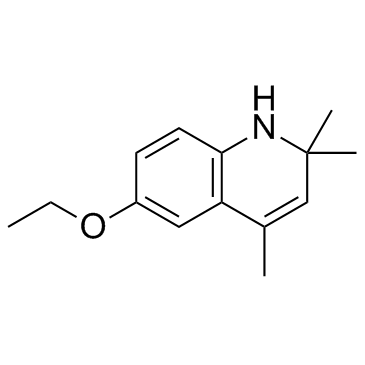Fate and effect of the antioxidant ethoxyquin on a mixed methanogenic culture.
Anup G Shah, John A Pierson, Spyros G Pavlostathis
Index: Water Res. 39(17) , 4251-63, (2005)
Full Text: HTML
Abstract
The potential inhibitory effect of ethoxyquin, an antioxidant commonly used as a preservative in the food processing industry (e.g., for stabilizing dissolved air flotation residuals), was evaluated at concentrations up to 300 mg/L using a mixed, mesophilic (35 degrees C) methanogenic culture and dextrin, peptone and methanol as the carbon source. A batch assay conducted with a range of ethoxyquin concentrations did not result in any inhibition up to an ethoxyquin concentration of 75 mg/L, but severe inhibition of methanogenesis was observed at concentrations higher than 150 mg/L. Ethoxyquin addition to a batch reactor with the same mixed, methanogenic culture, at ethoxyquin concentrations gradually increasing over 100 days, resulted in a transient and a complete inhibition of methanogenesis at ethoxyquin concentrations of 150 and 300 mg/L, respectively. Acidogens were not significantly impacted, whereas aceticlastic and methanol degrading methylotrophic methanogens were impacted the most. Acclimation of the methanogenic culture to ethoxyquin was not observed over an incubation period of more than 100 days. Long-term (>100 days) incubation at sub-inhibitory ethoxyquin concentrations did not result in ethoxyquin biotransformation. Similarly, ethoxyquin biotransformation was not evident over an 8-day aeration period in a laboratory-scale activated sludge reactor operated under fully aerobic conditions. Ethoxyquin phase distribution tests conducted with the mixed, methanogenic culture at 1.61 g/L volatile solids concentration and nominal ethoxyquin concentrations equal to or higher than 300 mg/L resulted in solid phase/liquid phase ethoxyquin ratios equal to or higher than 1.0. The combined effect of ethoxyquin recalcitrance under anaerobic conditions along with its phase distribution, which favors biosolids, will result in ethoxyquin accumulation in anaerobic treatment systems used by the food processing industry. Such accumulation may pose concerns relative to inhibitory effects in these treatment systems and the disposal of ethoxyquin-bearing biosolids.
Related Compounds
| Structure | Name/CAS No. | Molecular Formula | Articles |
|---|---|---|---|
 |
Ethoxyquin
CAS:91-53-2 |
C14H19NO |
|
Modulation of ethoxyquin genotoxicity by free radical scaven...
2010-03-15 [Toxicol. Lett. 193(2) , 194-9, (2010)] |
|
Effects of a dietary antioxidant blend and vitamin E on fatt...
2014-07-01 [Poult. Sci. 93(7) , 1658-66, (2014)] |
|
Effects of a dietary antioxidant blend and vitamin E on grow...
2014-07-01 [Poult. Sci. 93(7) , 1649-57, (2014)] |
|
Effect of antioxidant inclusion and oil quality on broiler p...
2011-04-01 [Poult. Sci. 90(4) , 922-30, (2011)] |
|
Regulation of aldehyde reductase expression by STAF and CHOP...
2004-01-01 [Genomics 83(1) , 119-29, (2004)] |